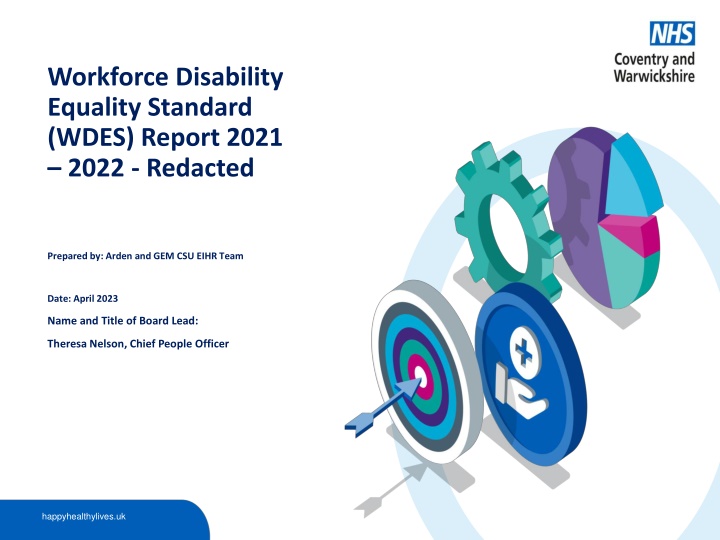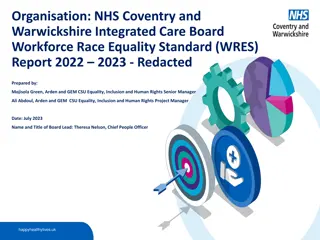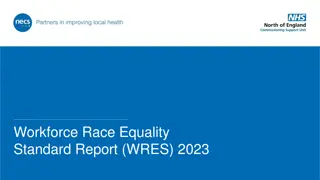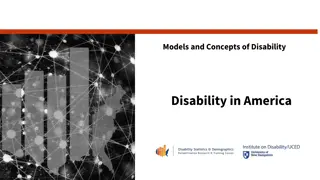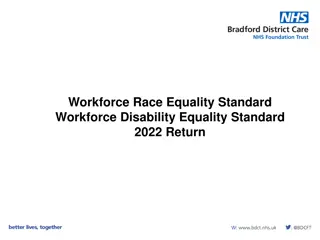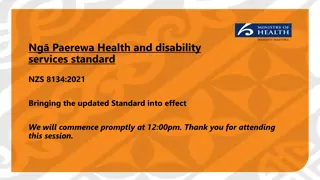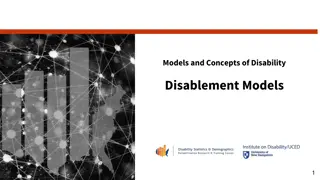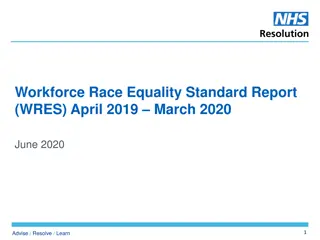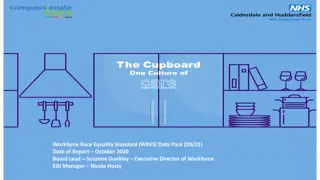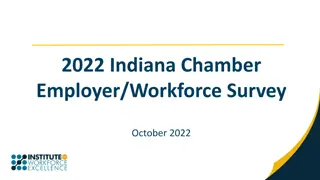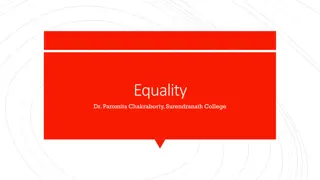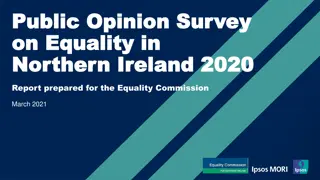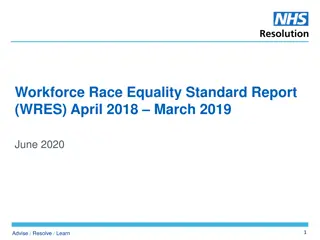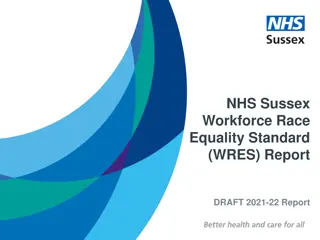Workforce Disability Equality Standard (WDES) Report 2021
The Workforce Disability Equality Standard (WDES) Report for 2021-2022 provides a comprehensive overview of key metrics, action plans, and insights related to disability equality in the NHS. This report aims to facilitate comparison and progress tracking in disability inclusion efforts within healthcare organizations.
Download Presentation

Please find below an Image/Link to download the presentation.
The content on the website is provided AS IS for your information and personal use only. It may not be sold, licensed, or shared on other websites without obtaining consent from the author.If you encounter any issues during the download, it is possible that the publisher has removed the file from their server.
You are allowed to download the files provided on this website for personal or commercial use, subject to the condition that they are used lawfully. All files are the property of their respective owners.
The content on the website is provided AS IS for your information and personal use only. It may not be sold, licensed, or shared on other websites without obtaining consent from the author.
E N D
Presentation Transcript
Workforce Disability Equality Standard (WDES) Report 2021 2022 - Redacted Prepared by: Arden and GEM CSU EIHR Team Date: April 2023 Name and Title of Board Lead: Theresa Nelson, Chief People Officer happyhealthylives.uk
Contents Introduction 3 WDES Metrics 4 Summary of WDES 5 NHS People Plan 6 Metrics 1 &10 7 Metrics 2 & 3 8 Metric 4 9 Metrics 5 to 9 10 Staff Engagement 11 WDES Action Plan 12 Further information and contact details 13 happyhealthylives.uk
Introduction The Workforce Disability Equality Standard (WDES) is a set of ten specific measures (metrics) which enables NHS organisations to compare the workplace and career experiences of staff with disability and staff without disability. NHS organisations use the metrics data to develop and publish an action plan with year-on-year comparisons to demonstrate progress against the indicators of disability equality. As part of our continuing improvement approach and commitment to developing good practice the ICB voluntarily completed WDES data using the NHSE submission template. The information presented in this report is directly related to the old organisation, the Coventry and Warwickshire Clinical Commissioning Group (CCG), covering 2021-2022 period. The data used is a snapshot of 31stMarch 2022. However, The new organisation, the Coventry and Warwickshire Integrated Care Board, came into being on the 1stJuly 2022 and will take forward the related actions. The report has the following key roles: To enable organisations to compare their performance with others in their region and those providing similar services, aiming to encourage improvement by learning and sharing good practice To provide a national picture of WDES in practice, to colleagues, organisations and the public on the developments in the workforce disability equality agenda Note on data: Headcounts below 5, and any associated headcounts which could be used to calculate headcounts below 5, have been redacted. happyhealthylives.uk
The Workforce Disability Equality Standard (WDES) Metrics 1 Percentageofstaff with disabilityin each oftheAgenda forChangeBands 1-9 OR Medicaland Dentalsubgroups, and VSM (includingexecutive boardmembers) comparedwith the percentageofstaffin the overall workforce 2 Relative likelihood of staff with disability compared to staff without disability being appointed from shortlisting across all posts. Relative likelihood of staff with disability compared to staff without disability entering the formal capability process 3 4 Percentage of staff with disability compared to staff without disability experiencing harassment, bullying or abuse from patients/service users, their relatives or other members of the public, managers, other colleagues Percentage of staff with disability compared to staff without disability believing that their organisation provides equal opportunities for career progression or promotion. 5 6 Percentage of staff with disability compared to staff without disability saying that they have felt pressure from their manager to come to work, despite not feeling well enough to perform their duties. 7 Percentage of staff with disability compared to staff without disability saying that they are satisfied with the extent to which their organisation values their work. 8 Percentage of staff with disability saying that their employer has made adequate adjustment(s) to enable them to carry out their work. The staff engagement score for staff with disability compared to staff without disability and the overall engagement score for the organisation 10 Percentage difference between the organisation s Board voting membership and its organisation s overall workforce 9 happyhealthylives.uk
Summary of WDES DeclarationRate (data quality) The NHS Coventry and Warwickshire Integrated Care Board disabilitydeclarationrate is 3.06% on ESR. The NHS anonymousStaff Survey shows18.9% % declarationa disability. In Coventry and Warwickshire17.30% of people declared a disability.The gap between staff representationand population representationis -15.84%. Metric 1 & 10 Agenda for Change Bands: There is significant under representation at all pay bands. On average 3.5% of non clinical staff have declared a disability. However, there is no representation at band 8c and above. For clinical staff, on average 2.3% have declared a disability. Figures remain lower at all levels. Board Members: The representation of people with disability at Board level is currently unknown. With 12 board members, there is good prospects for change Candidates without disability were 7.45 times more likely to be appointed from shortlisting compared to applicants with disability. There was also an under representation of applicants with disability in overall appointments Less than 5 staff with disability entered the capability procedure this financial year as compared to 20 staff without disability. The likelihood of staff entering the formal capability process is 0.18 time for staff with disability and 0.07 for staff without disability. This means that the likelihood of staff with disability entering the formal capability process is 2.58 time compared to staff without disability. 25.6% of colleagues with disability experience bullying, harassment or abuse from patients/service users or the public. 7.1% of colleagues with disability experience bullying, harassment or abuse from managers. 16.3% of colleagues with disability experience bullying, harassment or abuse from other colleagues. 53.8% of colleagues with disability experience bullying, harassment or abuse reported it. All 5 metrics score poorer for colleagues with disability compared to colleagues without disability 35.7% of staff with disability believe the CCG provides equal opportunities for career progression or promotion. This is 19.2% less than staff without disability 21.4% of staff with disability feel pressure from their manager to come to work despite not feeling well. This is 8% higher than staff without disability 35.7% of colleagues with disability feel their work is valued by the ICB, compared to 51.1% for colleagues without disability 70% of colleagues with disability feel they have sufficient adjustments in place to carry out their duties. This is 11% less than the median at 81.3% All 5 metrics are behind the CCG median benchmark for colleagues with disability Metric 2 Metric 3 Metric 4 Metric 5 6 7 8 9 happyhealthylives.uk
NHS People Promise There is strong evidence that where an NHS workforce is representative of the community that it serves, patient care and the overall patient experience is more personalised and improves . The NHS People Promise sets out the approach to support transformation across the whole NHS. It focuses on how we must all continue to look after each other and foster a culture of inclusion and belonging. " The detail of the People Promise can be found here The WDES is deeply rooted in the fundamental values, pledges and responsibilities set out in the NHS People Promise. happyhealthylives.uk
Metric 1 and 10 Narrative What is the data telling us? Agenda for Change Bands: There is significant under representation at all pay bands. On average 3.5% of nonclinical staff have declared a disability. However, there is no representation at band 8c and above. For clinical staff, on average 2.3% have declared a disability. Figures remain lower at all levels. Note on data: Headcounts below 5, and any associated headcounts which could be used to calculate headcounts below 5, have been redacted and the associated table has been removed as the redacted table was essentially void. This was to ensure that staff and board members could not be easily identified. Board Members: The representation of people with disability at Board level is currently unknown. With 12 board members, there is good prospects for change What are we planning The ICB will consider how to attract more applicants with disability Encourage a higher declaration amongst staff and board members on ESR Promote the importance of disability declaration through ongoing communications. happyhealthylives.uk
Not Developing achieving Metric 3 Metric 2 Relative likelihood of staff being appointed from shortlisting Relative likelihood of staff entering the formal capability process 7.45 2.58 With disability - - 88 appointees (95.65%) 20 Without disability What is the data telling us? Metric 2: Candidates without disability were 7.45 times more likely to be appointed from shortlisting compared to applicants with disability. Metric 3: Less than 5 staff with disability entered the capability process this financial year as compared to 20 staff without disability. The likelihood of staff entering the formal capability process is 0.18 times for staff with disability and 0.07 for staff without disability. This means that the likelihood of staff with disability entering the formal capability process is 2.58 times compared to staff without disability. However, the number of staff with disability entering the formal capability process was fewer than n=5 and are too small to identify any trends (n=<5 are represented by "- ). Therefore, comparedto last year there is an increase overall in number of staff entering formal disciplinary. What have we done over the last year? Provided Staff Training based on suggestions and information provided from staff, around: Unconscious Bias Collated an EDI Question for Recruitment Panels Encouraged staff to join National EDI Networks What are we planning Metric 2: Review recruitment data to understand if there are barriers for candidates who have a disability deep dive into our recruitment Focus on how to attract more applicants with disability (applicants with disability make up 7.50% of all applicants and 17.30% of the Coventry and Warwickshire population), Focus on how to appoint more applicants with disability (applicants with disability make up 1.08% of all appointments and 17.30% of the Coventry and Warwickshire population). Metric 3: Continue regular monitoring and reporting on grievance, disciplinaries, capabilities happyhealthylives.uk
Not Metric 4 achieving Percentage of staff of staff experiencing harassment, bullying or abuse from: With disability Without disability Median Median With disability for CCGs Without disabilityfor CCGs 4a) patients / service users, relatives or the public, 25.6% 16.5% 12.0% 8.0% 4b) managers, 7.1% 9.9% 12.7% 7.2% 4c) other colleagues, 16.3% 12.3% 15.6% 8.1% 60.0% 4d) Percentage that reported the incident 53.8% 46.2% 46.4% What is the data telling us? 25.6% of colleagues with disability experienced bullying, harassment or abuse from patients/service users or the public. This is more than double the median for CCGs at 12% 7.1% of colleagues with disability experienced bullying, harassment or abuse from managers. This 5.6% less than the median 16.3% of colleagues with disability experience bullying, harassment or abuse from other colleagues. This is 0.7% higher than the median 53.8% of colleagues with disability experience bullying, harassment or abuse reported it. This is 7.6% higher than the median The factors that may have impacted on the results could include: Covid-19 Merger of three CCGS into one in April 2021 What are we planning Ensure that processes addressing bullying and harassment are transparent, and set out the key routes to reporting incidents including options for anonymous reporting Embed Civility & Respect into Equality, Diversity and Inclusion training/ learning opportunities Promote Freedom to Speak Up services through ongoing communications happyhealthylives.uk
Metrics 5 - 9 Under achieving Metric 5 Metric 6 Metric 7 Metric 8 Metric 9 Percentage of staff believing that the CCG provides equal opportunities for career progression or promotion. Percentage of staffthat felt pressure from their manager to come to work, despite not feeling well Percentage of staff saying that they are satisfied with the extent to which their organisation values their work Percentage of staff saying that employer has made adequate adjustments at work With disability With Staff WDES staff survey questions 2021 engagementscore Year With disability Without disability 54.9% With disability 21.4% Without disability 13.4% With disability 35.7% Without disability 45.9% Without disability 6.8 disability 6.5 2021 35.7% 70.0% CCG Median 56.5% 63.0% 15.0% 11.2% 51.1% 58.9% 81.3% 6.9 7.2 What is the data telling us? All 5 metrics score poorer for colleagues with disability compared to colleagues without disability 35.7% of staff with disability believe the CCG provides equal opportunities for career progression or promotion. This is 19.2% less than colleagues without disability 21.4% of staff with disability feel pressure from their manager to come to work despite not feeling well. This is 8% higher than colleagueswithout disability 35.7% of colleagues with disability feel their work is valued by the ICB, compared to 51.1% for colleagueswithout disability 70% of colleagues with disability feel they have sufficient adjustments in place to carry out their duties. This is 11% less than the median at 81.3% All 5 metrics are behind the CCG median benchmark for colleagues with disability What are we planning Encourage and promote the stories/lived experiences of the contributions of staff with disability in a range of roles across the ICB Ensure that processes are transparent, and set out the key routes to reporting incidents including options for anonymous reporting Explore the delivery of a range of disability equality training in specific areas such as mental health, physical and sensory disabilities, neurodiversity and hidden disabilities happyhealthylives.uk
Metric 9 Staff Engagement In adopting and implementing the WDES, the Coventry and Warwickshire ICB should engage with staff, staff networks (particularly staff with disability networks), to ensure that staff with disability feel valued, included and respected for the outstanding contribution they make. Staff with disability involvement is a fundamental part of the whole approach that underpins the WDES. It is important that staff with disability are fully involved in the WDES implementation. Created a wellbeing programme based on staff feedback via a staff wellbeing survey which takes place every 6 months. Workshops have included: Sleep Healthy eating cooking demo Personal Safety Awareness Meditation Yoga Mental Health Suicide Awareness (clinical lead) Agile Working Menopause aligned with healthy eating and mental health We produced an informative and fun wellbeing content for the staff newsletter with a regular section. Conducted a system wide health needs assessment across Coventry and Warwickshire with all workforces in health and social care For significant improvements to be achieved against the WDES metrics, it is essential that the voices of staff with disability continue to be heard. The disability network can provide an important source of knowledge, support and experience, and provide a platform for increasing the visibility of staff with disability. This provide a safe place for staff with disability to share their experiences and be listened to in a compassionate and respected way. What have we done over the last year? Our focus in 2021 was to promote and progress Equality, Diversity and Inclusivity around the Disabilities protected characteristic, especially those with Hidden Disabilities for those who work for the ICB and in the work of the ICB. We: Raised awareness around Asperger Syndrome, hearing difficulties, Downs Syndrome, Epilepsy, Autism, MS, Ehlers-Danlos Syndrome, Accessibility, Learning Disabilities and Post Traumatic Stress Disorder, Dyslexia, Stammering and Sight awareness, World Hearing Day, World Alzheimer s Day, World AIDS day Provided resources around Unconscious Bias and Micro-Aggressions Organised Social Event for Network Staff Provided Staff Training based on suggestions and information provided from staff, around: Dyslexia and Neurodiversity Performance in the Workplace, Anxiety Disorders and Stress, Bipolar & Depression, Deaf Awareness Training Shared Disability Guides Provided an online Signature British Sign Language (BSL) for Beginners to staff What are we planning Develop a timetable of listening events with specific themes and topics in consultation with staff with disability they would like to discuss with the Executive Team. Engage staff with disability in the delivery of reasonable adjustment training. Wider staff engagement through the newsletter happyhealthylives.uk
Action Plan 2022 2025 Metric Objective Action Lead Date Milestone RAG 1, 2 &10 Increase declaration rates of employees with disabilities The ICB will consider how to attract more applicants with disability Establishment of communications plan Regular staff with disability stories and features as blogs and vlogs which promote importance of declaration Regular articles and information on how to record disability through ESR Promote these stories on ICB website and intranet to help with increased declarations at application stage and increase applications from individuals with disabilities. Consider how to attract more applicants with disability Check that all JDs and person specifications are accessible and free from ableness bias Ensure inclusive and accessible messaging e.g. employer brand collateral in accessible formats Monitor disability status of candidates on longlists and shortlist Encourage a higher declaration amongst staff and board members on ESR NHS People Plan Theme: Promote the importance of disability declaration through ongoing communications. Growing for the future Belonging in the NHS Embed EDI interventions into the recruitment process Review recruitment data to understand if there are barriers for candidates who have a disability deep dive into our recruitment. Focus on how to attract and appoint more applicants with disability 3 Ensure that capability data is captured including by disability Regularly monitor and report on grievance, disciplinaries, capabilities Continue regular monitoring and reporting on grievance, disciplinaries, capabilities NHS People Plan Theme: Looking after our People Belonging in the NHS Continue to support and develop staff groups such as an EDI staff network and its activities to advance disability equality within our ICB Embedding reliable data capture by disability 4 5 6 7 8 Developing a culture where staff with disability (and candidates) feel confident and reach their full potential Ensure that the processes addressing bullying and harassment are transparent, and set out the key route to reporting incidents including options for anonymous reporting. Establishment of communications plan Regular staff with disability stories/lived experiences and features as blogs and vlogs which promote and highlight key issues for staff with disability. These may be both positive or negative but seek to create a more inclusive culture in line with ICB values and behaviours NHS People Plan Theme: Looking after our People Belonging in the NHS Growing for the future Enhance our ICB approach to reporting of bullying, harassment and abuse at work Embed Civility and Respect into Equality diversity and Inclusion training /learning opportunities. Implement and embed a process for reporting bullying and harassment and provide relevant support Ensure that ableism and ableness bias is defined within in our bullying and harassment processes, policies and procedures Promote Freedom to Speak Up Services through ongoing communications. Carry out a Learning Needs Assessment (LNA) on what gaps are present in staff knowledge and awareness Present findings to EDI Group Identify resources required to deliver training to staff 9 Involve and engage with staff with disability in decision- making Encourage and promote the stories/lived experiences of the contributions of staff with disability in a range of roles across the ICB Discuss topic areas with EDI staff network Develop timetable and schedule in meetings in line with Executive Team availability happyhealthylives.uk NHS People Plan Theme: Growing for the future Belonging in the NHS Looking after our people Explore how stand-alone training could be delivered on reasonable adjustments aimed at wider audience of employees Start delivering training Explore the delivery of a range of disability equality training in specific areas such as mental health, physical and sensory
Further information and contact details To know more If you would like to discuss any element of this report, please contact: Executive Sponsor: Or Equality, Inclusion and Human Right Team agcsu.equality@nhs.net happyhealthylives.uk
